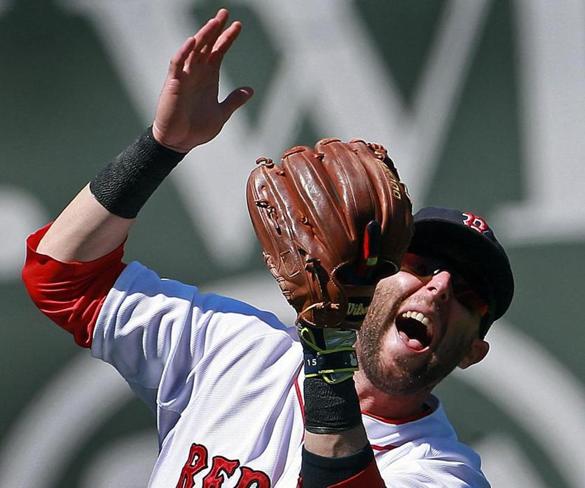Christopher L. Gasper’s passive voice approach to fixing the Red Sox
 “Something must be done.” It’s the passive-voice cry of the handwringing editorial or the concerned memo. And it’s vacuous and worthless, since it doesn’t say who must do what. I’ll illustrate with Christopher L. Gasper’s article in today’s Boston Globe: “It’s time for the Red Sox to call for a changeup.”
“Something must be done.” It’s the passive-voice cry of the handwringing editorial or the concerned memo. And it’s vacuous and worthless, since it doesn’t say who must do what. I’ll illustrate with Christopher L. Gasper’s article in today’s Boston Globe: “It’s time for the Red Sox to call for a changeup.”
The story so far: despite a high payroll, the Boston Red Sox started the season in disappointing fashion and with a few exceptions, have only gotten worse. The last-place Sox just lost six games in a row while fielding like Little Leaguers. (I have wondered if my cutting the cord and signing up for MLB.TV is what caused the slide. Some of my Facebook friends suggested a new hashtag, #BlameBernoff, but the rest say it’s not my fault.)
In this situation, sportswriters must blame somebody besides me. Gasper’s writing continually lives up to his name as he embraces hyperbole and strained and mixed metaphors that stand out even among the usual extremes of the sports pages. Today’s column perfectly illustrates how passive voice appears to suggest action without actually saying anything. Some excerpts, with passive voice highlighted in bold italic and other passive-type constructions in bold:
The only circumstance tougher to swallow than the continued losing by the Red Sox is the organizational response to it — or lack thereof. Instead of reacting, the Sox just keep waiting for the world to change, for their proprietary projections to come to glorious fruition. . . . [You can hear him loading both barrels.]
How bad does it have to get before someone in a position of authority or influence on 4 Yawkey Way decides to act, whether that’s changing the manager, recalibrating the roster or altering philosophical course? The Sox appear stuck in a state of organizational inertia, preaching patience, spouting platitudes, clinging to hope, and losing games. . . .There has to be an attempt to shake this team from its torpor. . . . Trying anything is preferable to doing nothing.[“Something must be done. I’m not sure what, but something.”]
“We’re not in a good place right now as a team, but it’s not because we’re not giving effort,” said [Red Sox Manager John] Farrell. “We’re not executing completely.” That has been a theme this season. It’s the residue of losing. It can’t be allowed to continue. . . . A move has to be made, a message has to be sent.
Here’s a translation with the passive voice removed:
The Red Sox are playing like pathetic losers. I wish I knew how to fix it, but I don’t. I just don’t like sitting around waiting for something good to happen.
I’m not a fantasy baseball geek, I’m just an intense fan. But I do understand statistics and the rhythm of the baseball season, including how managers work and what’s possible. And “Just do something, anything!”is not the right strategy. If Gasper or the Red Sox were being honest, here’s how the article would read:
The Red Sox suck. Manager John Farrell will keep tinkering to try to fix this. But let’s be honest, this team is not going to the playoffs, and it’s not going to the World Series. Firing the manager or the GM won’t change that. Radical short-term moves are stupid and wasteful. Instead, we should be planning for the long-term. Here’s what that means:
1. Play as many rookies as possible as much as possible. Yes, that will be ugly, but they’ll develop quickly and we’ll find out who’s really good.
2. Teach Hanley Ramirez to play his new position of left field, and Pablo Sandoval to play third-base properly. Run a fielding clinic, as you would in spring training. From time to time, put in good-fielding rookies in these positions to show them how’s it done. Yes, I know how much you’re paying them, but that’s what they need.
3. Keep playing the aging (late-30s!) designated hitter David Ortiz to see how much he has left in the tank.
4. These moves can’t make things any worse, but they probably won’t make them much better. However, at the trade deadline, it will be a lot clearer what’s worth saving. Trade the mature stars who aren’t worth keeping for prospects. Give the players who remain another half-season to develop. At least that would be fun to watch!
5. At the end of the season, you’ll know whether John Farrell is part of the problem or part of the solution. Keep or fire him then, not now.
6. Go back to winning in 2016.
You may or may not agree with my baseball suggestions. But at least you know what they are, which more than I can say for Christopher L. Gasper’s writing.
Photo: Jim Davis, Boston Globe
A Yankee fan can’t write that any better.